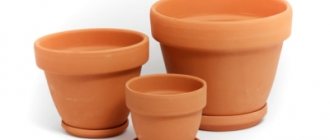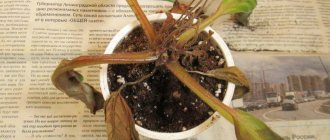Saintpaulia is an ornamental plant that does not require careful care.
In order for an indoor flower to produce buds and flowers abundantly, it must be replanted on time, adhering to all the rules.
Indoor Saintpaulia is replanted once a year in the spring..
During this period, the flower recovers from winter sleep, and all its metabolic processes accelerate.
How to know if it's required
Sometimes it happens that there is still a lot of space in the pot and the grower decides not to replant the plant.
You can find out whether you should replace the pot by the following signs:
- The stem at the bottom is bare . In this case, the lower leaves of the violet dry out and fall off, leaving the base “bare.”
- The soil in the pot is too acidic and no longer contains nutrients.
- A whitish layer of soil appeared on the surface of the earth . This phenomenon means that the earth is oversaturated with mineral fertilizers.
- The lump of earth is entwined with old roots , the earth is practically invisible. To understand how much space is left for roots, you need to lift the flower by the leaves and free it from the pot.
If one or more factors are present, the soil and pot for Saintpaulia need to be urgently replaced.
Symptoms indicating the need to replace the soil
Signs of poor soil condition and urgent replacement are:
- White coating on the surface is a factor of oversaturation with mineral salts and poor air permeability;
- Alkalinization - watering with hard water. Yellowing and discoloration, and subsequently the acquisition of a brown tint and drying of the tips of the leaf blades;
- Bareness of the stem - the soil is not able to provide nutrition;
- Changing shape leaves, flowers;
Old soil may cause problems with leaves. - Proliferation of the root system - roots coming to the surface or into drainage holes;
- The plant releases a new rosette;
- Pests;
- Diseases caused by poor air permeability.
Important! A depleted and compacted soil mixture is unable to provide the plant with nutrition and moisture.
When is the best time to replant?
The most unfavorable time to transplant violets is winter and summer. At these times of the year, the plant does not take root well, and in the future it loses its decorative properties.
It is better to replant Saintpaulia in spring and autumn with additional lamp lighting . The most favorable time is May.
If the violet variety is special and rare, then it is better to focus on the period of budding and flowering of the flower. The appearance of new shoots and flowers is an indicator of the normal growth of Saintpaulia, which does not need to be replanted.
Experienced flower growers occasionally focus on the position of the Moon relative to the planet. It is recommended to transplant Saintpaulia to the waxing Moon.
Lunar calendar to help the gardener
It is best to plant and replant violets in the spring. Daylight hours increase, and the likelihood that the plant adapts well to new conditions increases.
There is too little light in autumn and winter. In the summer heat, the capricious violet is also unlikely to take root.
When choosing when to plant indoor violets, some gardeners prefer to focus not only on the seasons, but also on the lunar phases according to the lunar calendar.
Everyone has long known that the Moon influences all living things on our planet. Therefore, it will not be superfluous to stick to favorable and unfavorable days. So, when to plant according to the lunar calendar:
- Favorable days for planting Saintpaulia are the days of the “waxing moon”. It is believed that during this period the roots of the plant are least likely to react to damage;
- if there is a need for an emergency transplant, it can be performed during the days of the “aging moon”;
- On the days of the full moon and new moon, the lunar calendar categorically prohibits any manipulation with whimsical plants.
| Lunar landing calendar for March 2022 | ||
| from 1 to 8 March | Waxing Crescent | Favorable days for transplantation |
| 9th of March | Full moon | No transplantation is carried out |
| from 10 to 23 March | Waning moon | For emergency transfer only |
| March 24 | New moon | No transplantation is carried out |
| from 25 to 31 March | Waxing Crescent | Favorable days for transplantation |
Is it possible to replant a flowering Saintpaulia?
We are often asked: is it possible to replant a blooming violet? One of our experts will answer this question for you.
Expert opinion
Klimkina Elena Vladislavovna
Florist, businessman. Organized her business on a country plot of land
First of all, you need to find out for what purpose you want to transplant. Just because the time has come, do you think the pot is too small, etc.? In this case, we would recommend that you wait until after flowering. After all, if a plant blooms, it means it is quite comfortable and in such conditions, no critical or dangerous processes occur.
But if you understand that the flower needs to be saved - for example, the soil in the pot has become sour, pests have infested, or the soil has already become too poor, then you need to act immediately. Even if the violet is blooming at this time.
Yes, it will most likely stop flowering, but at the same time you will save the plant
Partial substrate replacement
Partial replacement of soil in most cases is carried out on young, rooted plants . This method is typical for transplanting healthy violets that need an enlarged flower pot.
What does the procedure give?
Leaving a small lump on the root system ensures the safety of the roots from damage .
Delicate violets have very sensitive roots and are easily damaged by the slightest careless action, which leads to a slowdown in development.
Especially when it comes to very young plants with a weak root system.
How long can a complete transplant be postponed?
There is no specific time frame for completely replanting Saintpaulias. If the plant develops well, grows, and the flowering is lush and captivating, then you can wait with replanting . The transplant is aimed at replacing:
- Ground;
- Containers;
- Or pest and disease control.
But, if the plant feels great in its environment, then you can postpone .
In what cases is it not recommended?
Replanting with partial soil replacement is not recommended in the following situations :
- acidification or salinity;
When violet soil becomes salinized, it must be completely replaced.
Do I need to do this after purchase?
After purchasing Saintpaulia, you need to carefully inspect it , removing all dry flowers and rotten, damaged leaves.
Then you need to remove all unopened buds so that the violet can calmly endure the process of adaptation.
In the first few days, you should not water or fertilize the flower - the soil in the pot should dry out . Then the violet requires emergency replanting.
As is correct, flowers for sale are grown and exported in special pots with peat, which has no nutrients.
After transplanting, the violet should be covered with cling film or a thin bag to create greenhouse conditions. After a week and a half it is removed.
How to care after transplant
Transplanted plants should be kept in favorable conditions, subject to moderate soil moisture, good temperature and indoor lighting. For normal growth and development, violets require a temperature within 21-23 degrees and daylight hours of 10-12 hours. These delicate plants do not tolerate drafts, spraying and sudden temperature changes.
Watering should be careful and moderate: not all the soil has yet been developed by the roots, so water absorption will be slow. 2 weeks after transplantation, you can fertilize: first in small quantities, gradually increasing the dosage as for a regular adult violet.
In the video, the florist tells and shows how to transplant violets correctly.
Which soil to choose
To successfully transplant Saintpaulia, you need to prepare new soil and a suitable container.
You can buy soil at a specialty store or prepare it yourself.
You can find out how to choose soil for Saintpaulia and whether you can make it yourself from the material at our link.
The second option is preferable in the case of breeding rare varieties of flowers.
To create a universal substrate for violets, you will need turf soil, sand, humus and turf in proportions of 2: 1: 1: 0.5, respectively.
A prerequisite for preparing the mixture is its sterilization. The soil needs to be calcined in the oven for two hours, heated in a water bath, or use another method as desired.
Such soil can be used only on the fourth day.
The result should be soil with a fairly loose and airy structure and a slightly acidic pH. Before planting violets, the soil can be additionally shed with a weak solution of potassium permanganate for disinfection.
Varietal violets, for example “Dance of the Galaxy” and “Chimera”, are especially demanding on the substrate.
How to prepare container, plants and soil for replanting
In order for the violet to easily take root in a new place, it is necessary to follow some recommendations when preparing the container, nutrient substrate and the plant itself.
Capacity requirements
Any utensils after replanting the plant should be thoroughly washed and treated with a disinfectant solution. Indoor violets feel good in bowls up to 10 cm high with a top diameter of 15 to 20 cm. A mandatory item is the presence of holes for drainage. Such containers are optimal for transplanting an adult plant. For young rosettes, cups with a diameter of about 6 cm are suitable.
Plastic pots are best for growing violets because the soil in them dries out more slowly. When transplanting into plastic cups, the drainage layer must compensate for the depth to maintain proportions.
Transplanting into clay and ceramic pots is not the best option, since leaves that come into contact with the container often begin to wither. If, nevertheless, the choice fell on such dishes, then you can put raffia, sisal or coconut fiber under the lower leaves.
Plastic pots are best suited for transplanting violets.
Important. In each case, the diameter of the new pot should be 2.5-3.5 times smaller than the diameter of the plant itself.
Composition of the nutrient substrate
The soil for indoor violets should be crumbly, light, acidic with excellent water and air permeability. To obtain the optimal substrate, you can take 5 parts of ordinary chernozem from a garden plot, 3 parts of peat and 1 part of coarse river sand.
The composition must include sphagnum moss or undecomposed high peat, brick chips, perlite and vermiculite. The total amount of these additives should not be more than the sand taken. Pottery shards or expanded clay are suitable for drainage.
[adsp-pro-5]
To prepare the soil, it is allowed to take another composition: turf soil (2 parts), leaf soil (1), coniferous soil (1), crushed moss (1) and river sand (0.5) with the addition of charcoal. You can also purchase ready-made soil for Saintpaulias at a specialized store.
The resulting substrate must be steamed and disinfected with a solution of potassium permanganate. A couple of weeks before transplanting, you can add the EM-1 preparation to the ground, and before planting, a little vermicompost. During the replanting process, the soil should be moistened, but not lose its flowability.
As a primer, you can purchase a special substrate for violets.
Preparing the plant
Violets also require special preparation before transplanting. A few hours before transplanting, the soil is moistened enough so that the plant can easily leave the pot. At the same time, the soil should not stick to your hands and stain the leaves of the plant.
The removed plant is carefully examined, the roots are cleared of soil, and damaged ones are removed. Heavily overgrown roots can be thinned by 2/3 - this will not harm the plant in any way.
If there is rot, the violet is carefully cleaned and treated with ground charcoal. If the root is dead, the rosette can take root in water, after which it is planted in the soil in the usual way. For transplantation, warm, settled water is required.
Selecting a pot
The new capacity must meet several parameters.
The best option is a plastic pot, which is 2-3 centimeters larger in size than the previous one.
If the container is not new and has been used previously, then it must be cleaned of salt deposits and then treated with a solution of potassium permanganate.
Important! The pot should have holes at the bottom to allow excess water to escape. Drainage made of small stones, fragments of clay or expanded clay is also placed at the bottom.
The root system of violets does not tolerate waterlogging of the soil - the shoots quickly wither and the shoots rot.
Note! Our website has detailed material on how to choose a pot for violets. If you would like more information on this topic, please use our link. We also recently answered in great detail the question about methods of propagating violets and talked about the spectacular terry Saintpaulia “Amadeus”.
Preparing a container for violets
The flowering of a houseplant depends on the diameter of the pot. The container must be of optimal size. Usually they look at the size of the outlet, choosing a container diameter that is 5 centimeters larger.
The height of the container should not exceed 10 centimeters for medium-sized plants, and 5 centimeters is enough for miniature ones. The diameter of the pot should be 1-2 centimeters less than its height.
Violet containers must be selected according to the requirements, otherwise the plant will not bloom.
Flowers feel comfortable in plastic or ceramic flowerpots. There must be holes at the bottom of the container to drain excess water into the pan. Through them the soil in the pot will be better ventilated.
Transplant methods
Violets can be replanted using several methods - complete or partial replacement of soil, transshipment. Each of them has its own advantages and disadvantages, which allows them to be used in different situations.
Transshipment
The transshipment method is better suited if the flower has a fragile or unformed root system.
It must be used when new shoots have taken root after planting and then suddenly begin to wither.
To replant, Saintpaulia is removed from the pot along with the soil on the roots..
The gardener's task is to prepare a new pot with a larger diameter. The flower is placed in a new container so that the height of the new and old soil is at the same level.
The voids below and on the sides are filled with new soil.
Partial soil replacement
The partial soil replacement method is often used for replanting mini-cultivars. It involves removing the top layer of soil from the pot and adding a new layer. In this case, the pot may remain the same.
Complete soil replacement
Before completely replacing the earthen ball, it is necessary to moisten the soil in the pot using a spray bottle.
After this, the violet is pulled out by the rosette and its roots are washed under running water, getting rid of excess soil.
The plant should be left on a paper towel for a few minutes to allow the roots to dry naturally.
Please note that before planting in a new pot, the root system must be carefully inspected and, if necessary, rotten and dead areas of roots must be removed.
The broken or cut areas are sprinkled with crushed activated carbon for disinfection.
Transplanting violets during flowering
It is necessary for all flower growers to know how to properly transplant violets when they bloom. It is unlikely that there will be a gardener who wants to interrupt the picturesque flowering process without a good reason. But, if the reason really exists, then it is better not to hesitate, otherwise the gentle and moderately capricious Saintpaulia will begin:
- Waste away;
- And it will lose its presentable appearance quite quickly.
In what cases is it worth the risk of replanting a flowering pet? All causes are related to problems around the root or root system.
Some of them can wait until after the planned replanting or the end of flowering, but there are those that require immediate action:
- Swampiness of the soil mixture;
- Soil salinity;
- Acidity of the earthen coma;
- Putrefactive processes in the root system, accompanied by a musty smell of the soil;
- Destruction of a flower pot;
- Significant overfeeding with fertilizers;
- Abundant infestation of parasites.
Even one reason does not allow the plant to fully develop and receive sufficient nutrients during such an important period. Waiting until the deadline for a planned transplant can simply lead to disease or even death of the plant.
The violet must be transplanted into another pot.
If the indoor violet has:
- A strongly expanded rosette of a flower;
- Increased growth of the root system;
- A small number of parasites, the bulk of which are removed by immersion or drugs.
Important! In these cases, if the plant develops and blooms beautifully, you should wait until the planned date of replanting and not test it for stress resistance.
It is better to replant violets during flowering in the spring.
Main reasons
The condition of the soil is very important for the development and growth of violets
Particular attention should be paid to soil acidity. A pH in the range of 5.6-5.9 is ideal for the full development of violets
Acidity levels beyond these limits make nutrients unavailable to Saintpaulia.
Acidity caused by poor-quality water during irrigation or excessive use of fertilizers causes:
- Yellowing of sheets;
- And the falling buds.
The lack of phosphorus-nitrogen nutrition impairs the development of the plant and requires urgent replacement of the soil.
The appearance of microscopic parasitic insects in the above-ground or underground parts, sometimes invisible to the naked eye, can significantly disrupt the viability of indoor pets. Feeding on the juices of parts of the plant and especially disturbing the structure of young roots, they destroy the delicate plant before our eyes.
Important! Infectious diseases: fungal, bacterial or viral, have the ability to multiply rapidly and destroy a delicate violet in a matter of days.
Only changing the soil mixture coupled with the treatment procedure can save indoor Saintpaulias.
Do I need to remove buds and flower stalks?
Emergency replanting due to disease, soil depletion or pests is carried out regardless of:
- Vegetation stage;
- And the time of year.
During the flowering period, forced transplantation has its own characteristics. During this important phase for the plant, it spends all its strength and energy on the formation of:
- Butonov;
- Tsvetkov;
- Fruits with seeds
The main purpose of the violet is to produce offspring. But to do this, it needs to increase the appropriate volume of the crown and root mass. After transplantation into the flowering phase, the violet first of all needs strength to adapt and grow roots in the new soil.
And if you do not remove the existing or formed buds and flowers, then she simply will not have enough strength to devote them to flowering and growing other parts of the plant. It will weaken and will take a very long time to recover.
Therefore, having decided to transplant a blooming violet, the gardener needs to free it from buds and flowers so that it can direct all its strength to overcoming stress and the roots to take root.
The process is simple, but exciting. We simply take and tear off all the buds and flowers before removing the Saintpaulia from the pot, with the hope that the strengthened, transplanted plant will soon burst into lush blooms. After transplantation, the flower requires careful care.
Step-by-step instructions for transplanting at home
When replanting, you need to prepare a new container for the flower, a universal soil mixture that is suitable for perennial ornamental plants, and the flower itself.
A week before replanting, you need to reduce watering the violet so that the roots can dry out a little.
Step-by-step instructions for replanting Saintpaulia:
- moisten the soil with a spray bottle so that it does not stain your hands during the procedure;
- remove all excess soil from the violet roots, remove rotten areas;
- rinse the roots under running tap water and leave to dry on a paper towel;
- put a drainage layer at the bottom of the new pot - vermiculite, stones, clay shards;
- sprinkle the drainage with a small amount of soil mixture and then install the violet on it;
- place the Saintpaulia and carefully fill all the free space in the pot with soil, sprinkling it in small portions;
- a layer of earth is poured up to the beginning of the rosette , leaving it and part of the rhizome on the surface;
Do you collect violets? Then we recommend that you pay attention to very spectacular varieties that do not require special care - “Raisin”, “Duchess”, “Wedding Bouquet” and “Royal Lace”.
Soil depletion
Over time, the soil due to a long growing season:
The soil of violets becomes depleted over time.
Plant waste, accumulated after watering, fertilizing with fertilizers, work of the root system and simply time, makes the soil :
- Dense;
- compacted;
- With accumulated salts;
- And sometimes there is a white coating on the surface.
In this state of the soil mixture, the violet cannot develop and begins to wither. The shape and color of the leaf blades are lost, the flowers become smaller and fall off.
Flowering times are reduced and over time the plant may simply die . In this condition of the soil, the root system cannot fully function, which ultimately leads to the death of the plant.
Post-procedure care
After replanting, you need to make sure that the violet does not tilt on its side and is held firmly in the pot. Only after this can further care for the flower be carried out.
Proper watering
Since the earthen ball was moistened during transplantation, and the new soil is saturated with useful substances, the violet in the new place does not need watering so badly.
If the soil in which you planted the plant was slightly damp, it is better to postpone watering for one day. And if the soil was dry, then you can water it a little, but there should be literally 2 teaspoons of water.
Read more about how to properly water violets in the material at this link.
Possible mistakes
When replanting, inexperienced gardeners may make minor mistakes, which then slow down the growth of the flower or lead to its death.
These include:
- damage to the root system;
- excessive watering, which entails rotting of the roots;
- use of heavy soil;
- lack of drainage in the pot.
In case of excessive root pruning, a special preparation that is sold in a flower shop can correct the situation . Kornevin is used to stimulate the growth of new roots and the active growth of the flower itself.
If other mistakes are made, the violet must be urgently replanted, adhering to all the rules.
The rules for replanting violets can be changed for each individual case, because there are certain varieties of Saintpaulia that require special treatment. These include mini-versions and rare varieties.
If you care for your plants correctly and your violets are not blooming, we recommend that you familiarize yourself with the most common causes of this problem. This may be caused by diseases, pests or some other reasons.
Features of violet care
Having transplanted a violet, it is necessary to create conditions under which it will be comfortable
Particular attention should be paid to the following points:
- Lighting. Violet does not tolerate direct sunlight. She needs diffused light, at least 12-14 hours a day. In winter, a phytolamp will help.
- The soil should always be moist.
- You only need to water the violet with settled water. The best method is watering through a tray. At the same time, water is poured into the pan, the remains of which are removed after 30 minutes. You can use drip irrigation using a watering can with a long spout or a bulb syringe. At the same time, water drop by drop until water flows through the holes located at the bottom of the pot. Then stop watering and after 15 minutes the water is removed from the pan. In summer, when it’s hot, the pot with the plant can be placed in a bowl of settled water at room temperature for about one hour. After which it is removed and returned to its place.
- In summer, the plant is watered every day, but little by little. In winter, no more than twice a week.
- Violet leaves should not be sprayed. You can wash them off from dust in the shower, but be sure to leave the plant in the bathroom until the foliage is completely dry.
- Saintpaulia does not tolerate drafts, but she also does not like heating devices near her.
- The room temperature should be between +18-+25 degrees, and air humidity about 50%.
- Wilted flowers are best removed.
Latest articles about gardening
Monstera care at home photo Monarda perennial planting and care photo Anthurium male flower: how to care?
To learn how to properly care for violets, you need to follow certain steps and advice from experienced flower growers. However, the result is worth it: delicate violets will bloom wildly and delight the eye
It is important to remember about regular plant replanting, which helps to renew the root system and rejuvenate the flower itself. Subsequent care for violets is also required: moderate watering, fertilizing











